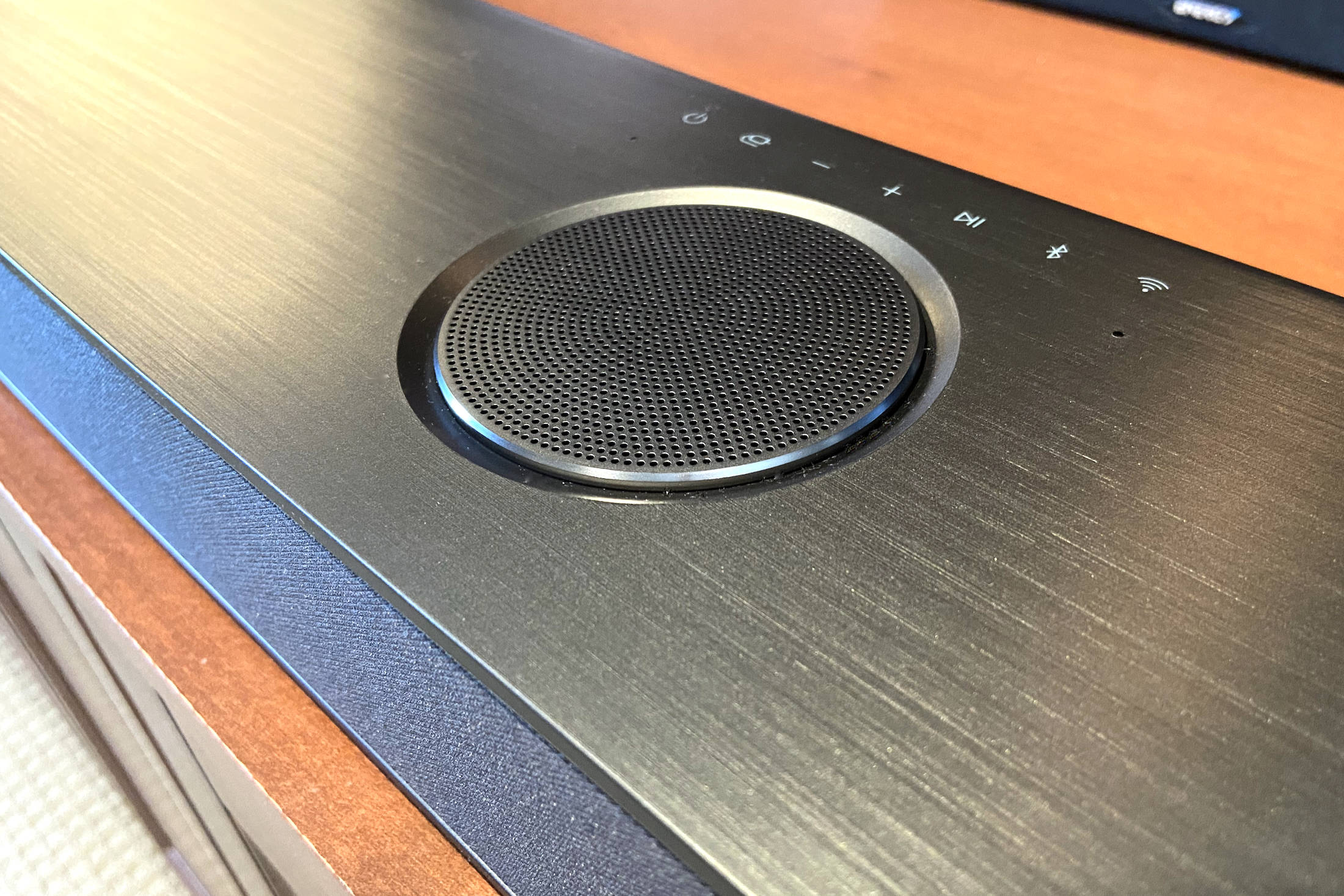
LG S95QR soundbar
MSRP $1,800.00
“LG’s S95QR is a complete Dolby Atmos home theater sound system in a box.”
Pros
- Impressive Dolby Atmos sound
- Plenty of app-based settings
- Two HDMI inputs
- Hi-res music support
- AirPlay and Chromecast built-in
Cons
- Bass lacks some rumble
- Poor instructions
- No way to save preferred settings
Riddle me this: When is a soundbar not a soundbar? Answer: When it’s a full-fledged replacement for a dedicated Dolby Atmos home theater system. I mean, yes, LG’s flagship soundbar, the $1,800 9.1.5-channel S95QR, is a soundbar. But that’s like saying the Burj Khalifa is a skyscraper — technically accurate, and yet also a massive understatement.
With a dedicated subwoofer, two wireless surround satellites with their own up-firing drivers, and tons of settings, inputs, and format support, about the only thing the S95QR has in common with a traditional soundbar is its total lack of speaker cables.
But now that you’re spending the equivalent of a full A/V receiver-based system, does the S95QR still offer enough advantages? Let’s see how this monster system-in-a-box stacks up.
What’s in that big box?
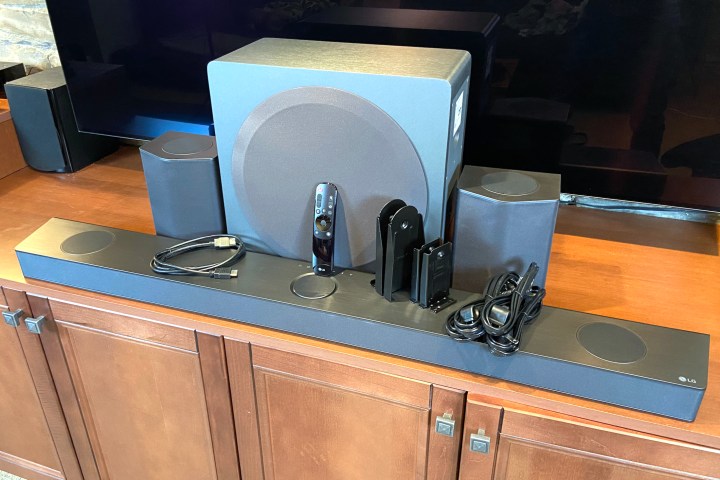
Why am I making such a big deal about the S95QR’s box? Because it’s massive. At 4 feet by 2 feet by 11 inches and weighing just over 33 pounds, you shouldn’t even contemplate sticking this thing in your car single-handedly unless your name is Dwayne Johnson.
And yet, for all its size, it’s a bit deceiving. A good chunk of the interior volume is used for empty cardboard boxes that act as spacers, because soundbars and subwoofers are inherently awkward shapes that don’t really fit into clean rectangular boxes.
Inside, you’ll find the main soundbar, the wireless sub, the two surround speakers, a remote with batteries, power cables for all of the speakers, an HDMI cable, and wall-mount brackets for the surrounds and soundbar. You’ll also find a quick setup guide that is barely enough to get you going (more on that later).
What you won’t find is much in the way of styrofoam or other plastics. There are still a few twist-ties and protective wraps, but there’s way less of that than in the past.
Design
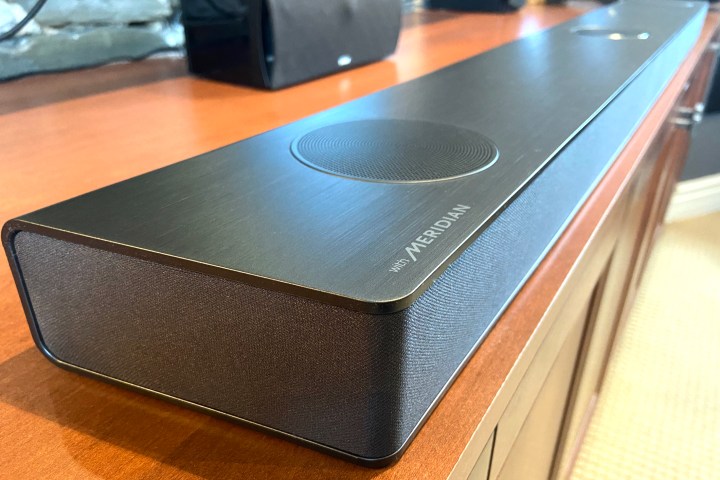
LG traditionally has favored understated, brushed-metal-and-fabric housings for its soundbars, and this approach is still on display with the S95QR. The main soundbar is fairly wide at 47 inches, but it keeps a low profile at only 2.5 inches in height. That’s low enough to stick under most TVs. But unless you’re planning to wall-mount it, don’t do that — the soundbar’s three up-firing height drivers need room to do their thing.
A set of touch controls grace the top surface, including power on/off, input select, volume, play/pause, Bluetooth, and Wi-Fi. In short, everything you could possibly need, and then some.
One of my chief annoyances with LG’s 2021 SP9YA Dolby Atmos soundbar was the hardwired power cord, which made placement and installation unnecessarily difficult. Thankfully, LG hasn’t made that mistake twice — the S95QR’s cord is fully detachable.

There’s a small alphanumeric display hidden behind the fabric grille that shows you a variety of info for your settings, but most of the time it will simply state what input you’re using (HDMI 1, ARC, Wi-Fi, and more). It automatically dims after a few seconds, but you can’t turn it off, which I found distracting at times, given that it’s always front and center. LG tells me that this will be addressed in a future software update.
The wireless subwoofer has a front-ported, side-firing design that’s slender enough that you can probably get creative with its placement, but not too creative — you won’t want to block that big circular grille.
The included wireless surrounds are outliers in the soundbar game: not only do they sport their own up-firing height drivers, but they also feature two full-range drivers that are angled outward from each other. That means you can position them beside or behind your viewing seats, which is something smaller, more directional speakers can’t quite do as effectively. But it also means that they’re much bigger than traditional soundbar surrounds, and finding a home for them if you don’t intend on wall-mounting them could prove challenging.
Connections
The S95QR is well-equipped for a variety of uses. You get two HDMI 2.1 inputs, both of which can pass through 4K video with Dolby Vision, HDR10, auto low-latency mode, and variable refresh rate (VRR) at up to 4K/60Hz. These last two specs will be mostly of interest to gamers.
The HDMI ARC/eARC is all you need to connect the soundbar to a TV. But if you prefer, an optical connection exists, too. Keep in mind that if you go with optical, you’ll lose several features, including any Dolby Atmos or DTS:X that might be coming from your TV, as well as the ability to control the soundbar’s volume/mute functions with your TV’s remote.
Sadly, there’s no way to hook your TV up to the HDMI ARC/eARC port and run a second device through the optical connection — the soundbar views them as fulfilling the same function, so it’s one or the other.
A USB port lets you access music files from a portable hard drive, a Bluetooth connection is included for casual audio streaming from a phone, and there’s Wi-Fi too, which enables a host of key music capabilities like Apple AirPlay 2, Chromecast built-in, and Spotify Connect.
As a hi-res capable speaker, you’ll be able to play lossless, 24-bit music from the USB port or streaming services over Wi-Fi, and even your personal music collection with a bit of extra work (more on that later).
Setup and ease of use
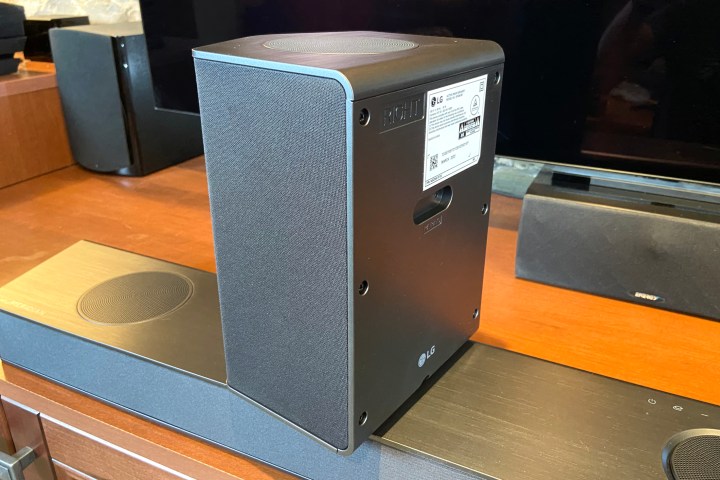
If you’ve ever installed a soundbar before, the S95QR won’t pose any problems. You plug the soundbar into your TV via HDMI (ideally) or optical (if you need to and have a cable), plug the subwoofer and surrounds into power outlets, then finish by plugging the soundbar into a power outlet. At this point, you’re good to go as far as TV sound is concerned.
But the included “simple” setup instructions aren’t exactly friendly for a first-timer. A complicated diagram and less-than-useful text makes it seem more confusing than the process I just outlined above.
Worse still, you’re provided with a QR code or a URL in the pamphlet so that you can download the full instructions. But take it from me — you do not want to try to read these on a phone. A tablet might work better. Instead, your best bet is to download the LG Soundbar app for iOS or Android and let it walk you through the various steps involved in getting the system fully up and running, including connections to your Wi-Fi network and triggering the soundbar’s AI-driven room-calibration sequence for the first time.
In fact, the Soundbar app will become your best friend. If you don’t avail yourself of its various menus and settings, you’ll be forced to use the included remote control in conjunction with the small, built-in display on the front of the soundbar. Since it can only show you a handful of characters at a time, you’ll need to decipher a variety of two-letter acronyms to figure out what you’re doing.
Admittedly, this is more of a problem when trying to adjust things like individual speaker levels than when switching between audio modes, but I cannot, for the life of me, understand why LG hasn’t given its flagship TV audio product an on-screen menu system. It makes the TVs that are supposedly the perfect companion to this speaker, and Sony has already proven how effective such an interface can be.
But even LG’s app has limitations. You get great control over the S95QR’s speaker levels — much better in fact than many of its competitors — as well as sound modes (music, cinema, sports, games, and more), EQ, and the ability to toggle features like auto volume and IMAX Enhanced, but there’s no way to save these as presets.
So let’s say that when you’re watching hockey, you find that reducing the bass, switching to sports mode, and increasing the level of the side speakers gives you the best results. But music and movies require a totally different combo. Unfortunately, you’ll need to make a note of these settings so you can dial them in each time you change from one type of media to another.
If all you want to do is control the volume, inputs, and audio mode, the included remote works just fine.
Sound quality
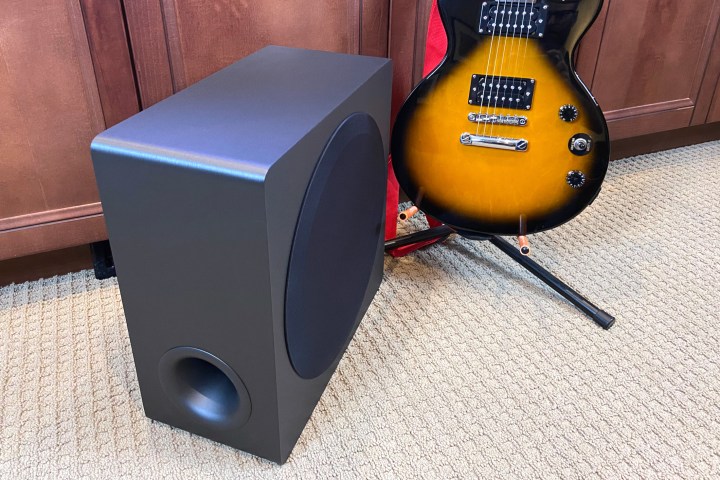
As you might expect from an $1,800 soundbar system, the S95QR does not disappoint on audio quality. Especially for high-octane movies, the presence of five up-firing height drivers and the additional four surround drivers makes a very convincing argument that we’ve now achieved something close to parity with wired, installed, A/V receiver-based home theater systems.
It’s not quite the same — my personal system’s overhead ceiling speakers are still better at creating a Dolby Atmos or DTS:X sphere of sound. — but given the convenience of being able to unbox and set up this soundbar in minutes, it’s a fair trade-off.
For movies
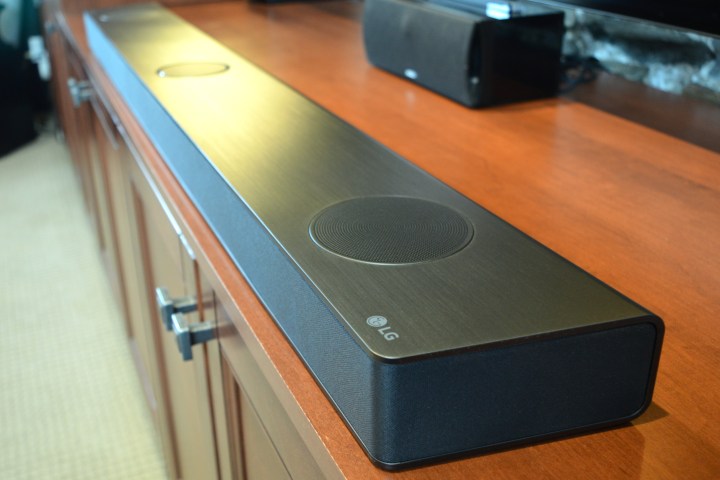
If you’ve got access to Dolby Atmos movies — say, via Netflix, Disney+, Amazon Prime Video, or Apple TV+ — and you have yet to hear them through a proper Atmos system, you’re in for a treat.
From bullets that ricochet around the room, to airplanes and helicopters flying overhead, or the realism of a live concert, the S95QR has no problem putting you in the center of it all.
I queued up some great Atmos titles like Mad Max: Fury Road and Ford v Ferrari, but it was Denis Villeneuve’s Dune that sealed the deal for me. The soundtrack on that film is like a member of the cast, and the multiple speakers ensured it was an Oscar-worthy performance.
For all of that audio excitement, dialogue remains clear and intelligible, regardless if you’re watching a full Atmos movie or a stereo TV show. For me, LG’s room calibration produced no noticeable difference. But I found that was true of the SP9YA, too, so your mileage may vary.
My recommendation is that you spend some time with the individual speaker levels in the app. In particular, boosting the height drivers can help deliver a more immersive experience if you’re sensing that the sound isn’t all that it ought to be.
If there’s one weakness, it’s in the low-end frequencies. That subwoofer has no problem delivering power, but it doesn’t rumble as much as others. It’s the difference between hearing bass and feeling it. I didn’t notice this on the SP9YA, but LG has changed the subwoofer design since that model, opting for a slimmer, side-firing layout over the older unit’s more boxy, front-firing setup. Perhaps the new box simply has less internal volume, and thus can’t move air as effectively? It’s hard to say. This is more of a note for those thinking of upgrading from an older system. If you’ve never owned a serious home theater before, I don’t think you’ll miss a thing.
For music
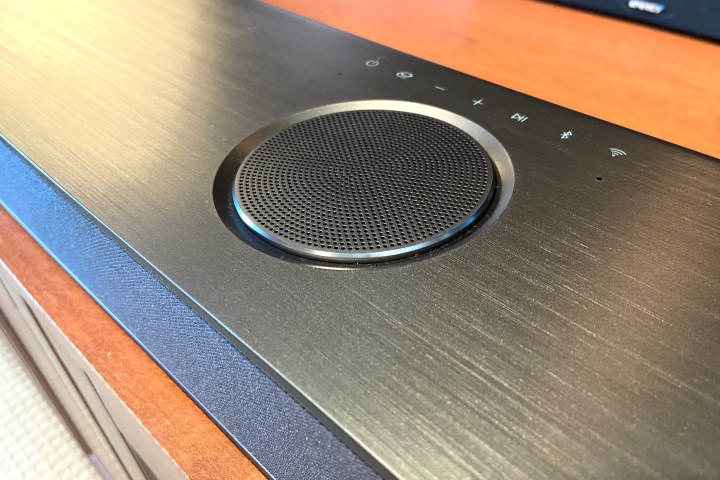
The S95QR is a solid choice for music, too, but there are a number of parameters that will affect your enjoyment. First, consider Bluetooth a fallback option. You’ll get far better results if you use AirPlay or Chromecast, which is not surprising given Wi-Fi’s vastly superior bandwidth. The system is hi-res compatible, but there’s no support for hi-res Bluetooth codecs like LDAC, aptX HD or aptX Adaptive, so again, Wi-Fi is your friend.
But because there’s no direct support for streaming music in the LG Soundbar app, you’ll need to make sure that your preferred music source has a Wi-Fi path to the S95QR. In other words, if you use an Apple device, make sure your service’s app works with AirPlay or Chromecast, or just Chromecast if you’re on Android.
The next thing to play with are the sound modes. LG includes a music mode that’s been tuned by Meridian, but don’t stop there. It’s good — a nice balance of frequencies that makes use of the soundbar’s bass capabilities — but I found I wanted to push the low-end even further, which sent me into deeper speaker levels and the bass/treble adjustments.
Listening to Dolby Atmos Music is a real thrill, but the only way to hear it currently is to use a streaming media player, like the Nvidia Shield TV 2019, hooked up to one of the HDMI inputs. Then, as long as you have access to Tidal, Apple Music, or Amazon Music’s library of Dolby Atmos tracks, you’ll get a very immersive experience.
Interestingly, even if you don’t have access to Atmos Music, if you ensure that the Surround Sound Setting is set to “on,” you can listen to standard two-channel stereo in an upmixed, 9.1.5 presentation, which is pretty awesome in its own right.
It’s worth noting that LG doesn’t provide any way to access music from your home network. So if you keep you tunes on a PC or NAS drive, you’ll need to use a third-party app to play them, and then use either AirPlay 2 (Apple devices) or Chromecast on Android to pipe them to the soundbar.
There’s also no built-in way to add the S95QR to a multiroom setup, although you’re not without options: Apple Home, Google Home, and Alexa can each be used to integrate this speaker system into a larger whole-home sound platform within those respective ecosystems.
Wait, 9.1.5?
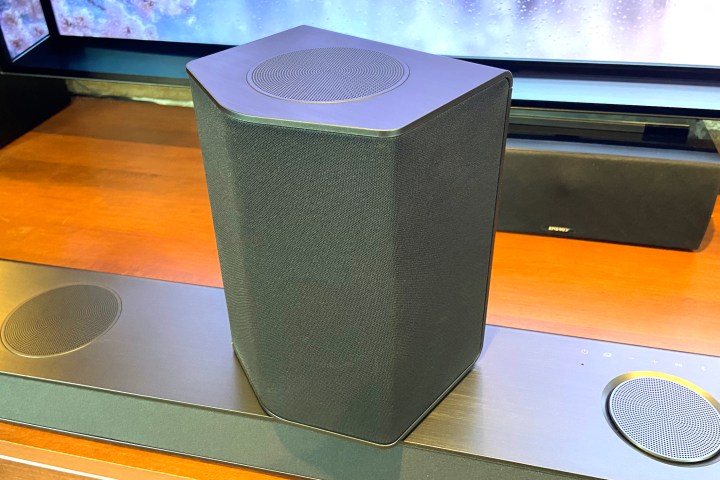
For the audio geeks out there, you may be wondering about LG’s declaration that the S95QR is a 9.1.5-channel system. The 9 and 1 are pretty straightforward — 9 surround channels and 1 low-frequency effects channel for the subwoofer. But 5 height channels? That’s a bit odd given that Dolby Atmos height channels are always even-numbered: .2 .4., or .6. LG tells Digital Trends that the central up-firing driver on the soundbar, which is credited with that mysterious fifth channel, isn’t actually a true channel from a soundtrack point of view — there is no fifth central height channel in a Dolby Atmos or DTS:X soundtrack.
Instead, LG is doing some clever signal processing to extract just the higher frequencies from the left and right front height channels, and is pushing these sounds to the central driver. I can’t say I was ever really aware of the difference that virtual height channel made, but more speakers is rarely a bad thing.
Our take
LG’s S95QR might be expensive for a soundbar, but let’s face it, with 14 channels, two wireless surrounds, a wireless subwoofer, and 810 watts of power, it’s a soundbar in name only. Let’s call it what it is: a full, home theater replacement that comes in one box and sets up in minutes. As such, it’s a total success, giving you an incredible amount of immersive audio for almost any listening you care to do, whether it’s a blockbuster movie soundtrack or a favorite album.
Is there a better alternative?
Right now, if you want a complete, Dolby Atmos-capable soundbar with dedicated up-firing drivers, rear surrounds, and a wireless sub, you should probably be looking at the Vizio Elevate. For $1,000 (or less when it’s on sale), it’s a great value. But the Elevate doesn’t offer any kind of Wi-Fi connectivity, so it can’t provide the highest-quality music experience, it’s not compatible with any smart home platforms, and it can’t work as part of a multiroom system.
The LG S95QR, however, does all of these things, and that means there’s only one real competitor at this price — the recently released $1,900 Samsung HW-Q990B. We haven’t had a chance to try the Q990B, but judging by its specifications, it’s an almost feature-for-feature match for the S95QR, with one key exception: it lacks Chromecast built-in, which might just be the tie-breaker if you’re on the fence.
How long will it last?
Soundbars, like most active speaker systems, should last as long as you need them to, and the S95QR is no exception. As time goes by, LG may not keep up with software updates, so it’s possible that some features that work today won’t work indefinitely — we’ve seen this with Sonos products in the past. Still, should this happen, it will most likely affect internet-connected features and not the S95QR’s core mission as a home theater solution that uses your TV as its primary source.
Should you buy it?
Yes. For the price, there is no single soundbar system-in-a-box that offers as much bang for the buck as the LG S95QR.
Editors’ Recommendations
